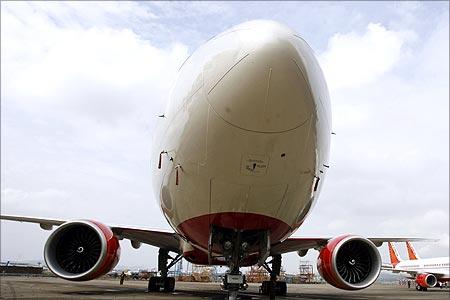Image: Air India.
Photographs: Reuters.
Photographs: Reuters.
Tough measures need to be taken to make Air India "survive and thrive", global airlines body IATA said on Wednesday, asking the government to take a cue from the merger of two state-owned Japanese carriers which slashed jobs and operations to come out of bankruptcy.
IATA chief Tony Tyler, who raised the issue at a CII conference on Indian aviation, said the entire sector was in a "multi-faceted crisis" which could be resolved by coordinatedpublic policies.
"To do that, we need an 'India Inc.' approach that addresses the crippling issues of high costs, exorbitant taxes and insufficient infrastructure," the Director General and CEOof the International Air Transport Association said.
Drawing a parallel between Air India merger and Japan Airlines (JAL) after its 2002 merger with Japan Air System, he said both of them faced global financial crisis, recession andfuel price hike soon after their merger.Hit by these problems, JAL filed for bankruptcy in 2010.
The Japanese government then launched a $3 billion restructuring plan and took "difficult decisions" to turn the merged airline around.
"The cuts were deep -- some 50 routes and 16,000 jobs. That's just short of a third of the workforce. With this bitter medicine, and other measures, JAL emerged frombankruptcy.
After reporting a $2.5 billion profit in 2011, it plans to re-list its shares this autumn," Tyler said in a clear indication that the government should take tough stepsto bring Air India out of the crisis.
Later, when asked whether he wanted Air India to be privatised, he said he did not suggest privatisation. The government should take steps to stabilise its operations first so that the airline could survive and thrive, he said.
IATA chief Tony Tyler, who raised the issue at a CII conference on Indian aviation, said the entire sector was in a "multi-faceted crisis" which could be resolved by coordinatedpublic policies.
"To do that, we need an 'India Inc.' approach that addresses the crippling issues of high costs, exorbitant taxes and insufficient infrastructure," the Director General and CEOof the International Air Transport Association said.
Drawing a parallel between Air India merger and Japan Airlines (JAL) after its 2002 merger with Japan Air System, he said both of them faced global financial crisis, recession andfuel price hike soon after their merger.Hit by these problems, JAL filed for bankruptcy in 2010.
The Japanese government then launched a $3 billion restructuring plan and took "difficult decisions" to turn the merged airline around.
"The cuts were deep -- some 50 routes and 16,000 jobs. That's just short of a third of the workforce. With this bitter medicine, and other measures, JAL emerged frombankruptcy.
After reporting a $2.5 billion profit in 2011, it plans to re-list its shares this autumn," Tyler said in a clear indication that the government should take tough stepsto bring Air India out of the crisis.
Later, when asked whether he wanted Air India to be privatised, he said he did not suggest privatisation. The government should take steps to stabilise its operations first so that the airline could survive and thrive, he said.


article